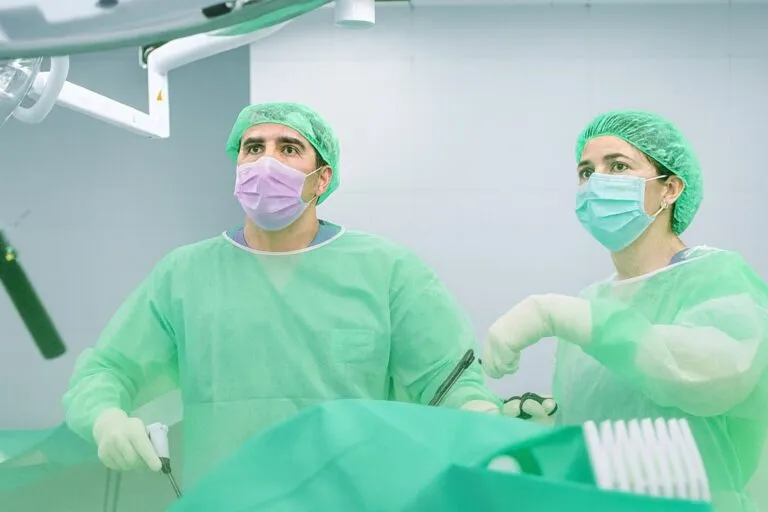At New Life Clinic in Kyiv, inguinal hernia surgery is performed using all known modern techniques, ensuring high efficacy and safety for our patients. But the main difference between us and other clinics is the unique patented immersion technique sutures (Patent for invention of Ukraine No. 49856 dated October 15, 2002), which allows not only to restore the normal position of organs and strengthen the hernial orifice, to guarantee the absence of risks of reoccurrence of a hernia, but also to almost completely eliminate any traces of surgery on the body.

Inguinal Hernia Surgery
Inguinal hernia treatment using minimally invasive techniques with minimal tissue trauma and fast recovery. We perform procedures of any complexity with precise control and full adherence to clinical guidelines.
- Top-Grade Surgeons
- Expert-Class Equipment
- Patented Surgical Technique
- Transparent Cost Calculation
Cost of Inguinal Hernia Surgery
We offer a fair and understandable price so that you can plan your treatment in advance. The cost of the surgery is formed transparently, because our goal is to make quality medicine accessible.
Hernia Surgical Treatment Expert at New Life Clinic

Hernia removal operations at New Life Clinic are performed by a top category herniological surgeon with 39 years of experience in Ukraine and the USA (Loma Linda University Medical Center, California).
David Noga is the founder and chief physician of the New Life Clinic, has 22 scientific works, 3 patents for inventions (including one patent of the international PCT standard) and patent rights for 2 useful models in medicine.
Patient Reviews
The language, style and spelling of the authors are preserved
Why Choose Hernia Surgery at New Life Clinic

COMPLEX APPROACH

MAKING THE RIGHT DECISIONS

MINIMALLY INVASIVE AND CARE

MODERN EQUIPMENT
Herniology Results in Numbers
Treatment of Abdominal Hernia at New Life Clinic – Photo Report
Surgical Treatment of Inguinal Hernia: What Is Important for the Patient
An inguinal hernia often causes anxiety and many questions, which is why we have gathered the essential information in one place. This section helps explain why a hernia occurs, how it manifests, which actions may worsen the condition, and which treatment methods are used. Such an overview prepares the patient for a conversation with the doctor and makes the next steps more understandable.
-
Causes of an Inguinal Hernia
-
Symptoms of an Inguinal Hernia
-
Actions That May Worsen the Condition
-
An Inguinal Hernia Never Resolves on Its Own
-
There Is No Non-Surgical Treatment for an Inguinal Hernia
-
Inguinal Hernia Repair Techniques
-
Fast Recovery After Surgery
Frequently Asked Questions From Patients
For many patients, making the decision to undergo surgery is not easy. There remain questions about safety, pain, risks, and outcomes. We have collected answers to the concerns that most often prevent people from taking the step toward treatment. This section helps you calmly evaluate the situation and feel confident knowing you are in safe hands.
-
Will It Be Safe? I’m Worried About Possible Complications
-
How Will I Feel After the Surgery? Will It Hurt?
-
Do I Need To Stay in the Hospital? I’m Afraid of a Long Hospitalization
-
Can I Be Sure the Hernia Won’t Come Back?
-
How Do I Know I’m Choosing the Right Clinic and the Right Surgeon?
-
What Happens If I Wait Longer? Maybe I Can Just Leave It for Now?
-
Will I Be Able To Return to Work and Daily Activities Quickly?
-
Are There Any Hidden Fees or Extra Charges?
Leave a Request – We Will Find a Convenient Time for You
Equipment and Facilities at New Life Clinic
The content on this page has been approved by the surgeon at New Life Clinic (David Noga, an abdominal surgeon with 39 years of practical experience).












































